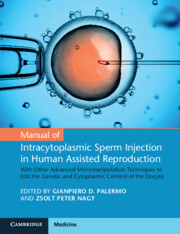 Manual of Intracytoplasmic Sperm Injection in Human Assisted Reproduction
Manual of Intracytoplasmic Sperm Injection in Human Assisted Reproduction Published online by Cambridge University Press: 02 December 2021
Micromanipulation technology has evolved rapidly over the past 30 years to meet the needs of assisted reproduction practitioners. The clinical outcome of micromanipulation and microinjection procedures is highly dependent upon practitioner skills as well as the quality and reliability of the equipment used. Well engineered mechanical, hydraulic and electronic micromanipulation systems are available and can be mounted upon inverted microscopes supplied by all of the major microscope companies. These systems are complemented by a range of oil and air injectors in addition to anti-vibration tables and lasers. In future, it is possible that some micromanipulation systems will become automated using computer algorithms, enabling robotic procedures to be performed, eliminating variability in practitioner performance.
To save this book to your Kindle, first ensure [email protected] is added to your Approved Personal Document E-mail List under your Personal Document Settings on the Manage Your Content and Devices page of your Amazon account. Then enter the ‘name’ part of your Kindle email address below. Find out more about saving to your Kindle.
Note you can select to save to either the @free.kindle.com or @kindle.com variations. ‘@free.kindle.com’ emails are free but can only be saved to your device when it is connected to wi-fi. ‘@kindle.com’ emails can be delivered even when you are not connected to wi-fi, but note that service fees apply.
Find out more about the Kindle Personal Document Service.
To save content items to your account, please confirm that you agree to abide by our usage policies. If this is the first time you use this feature, you will be asked to authorise Cambridge Core to connect with your account. Find out more about saving content to Dropbox.
To save content items to your account, please confirm that you agree to abide by our usage policies. If this is the first time you use this feature, you will be asked to authorise Cambridge Core to connect with your account. Find out more about saving content to Google Drive.